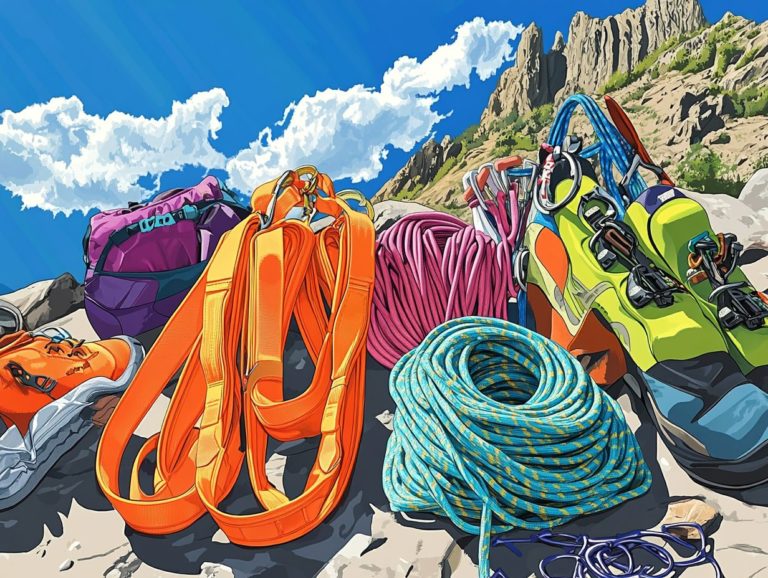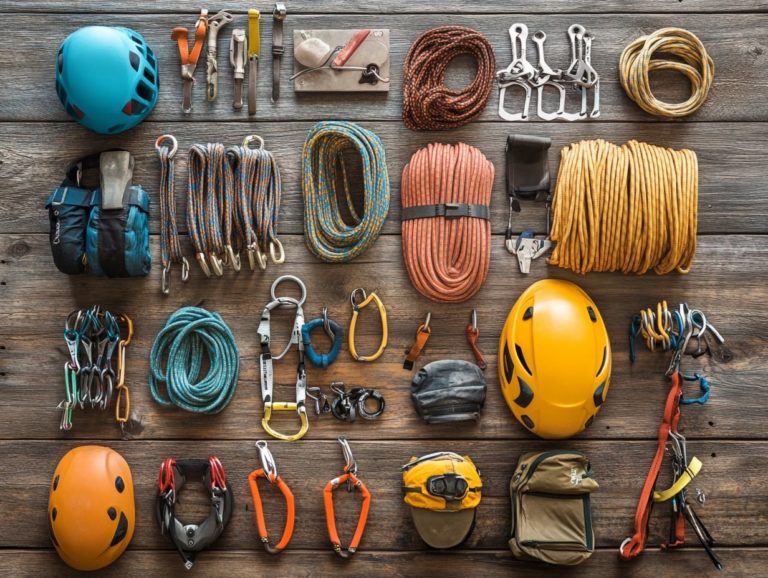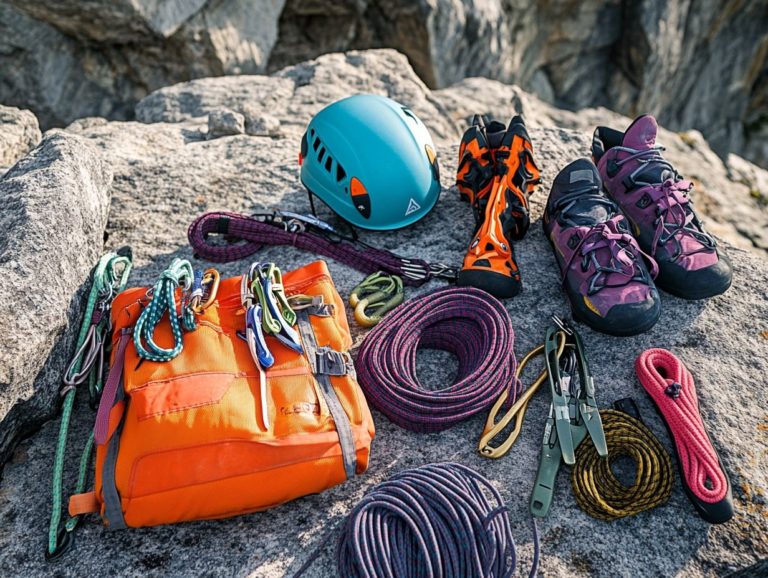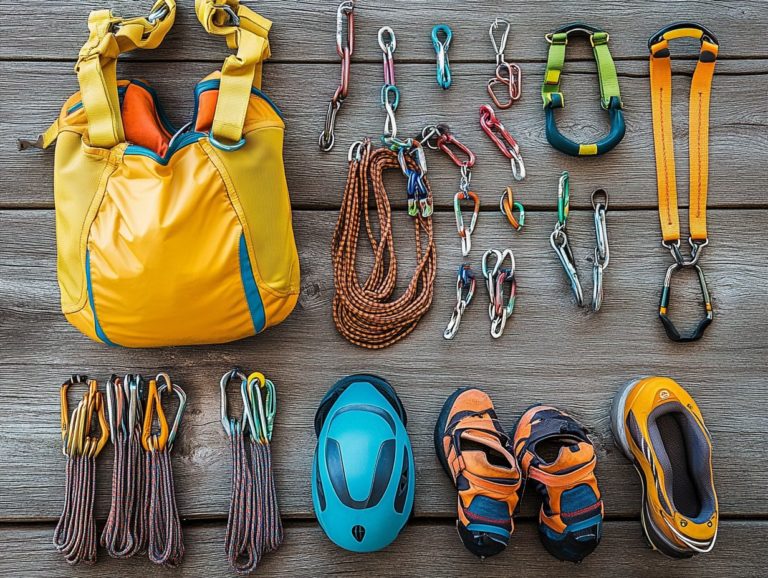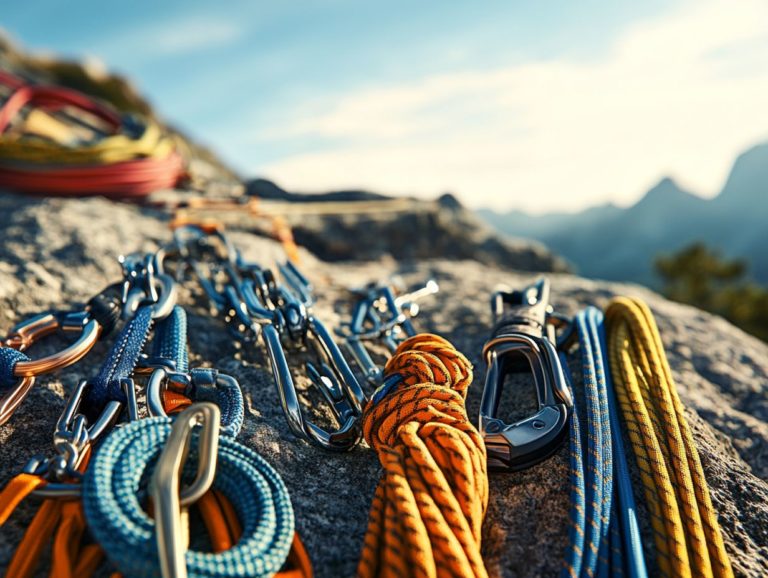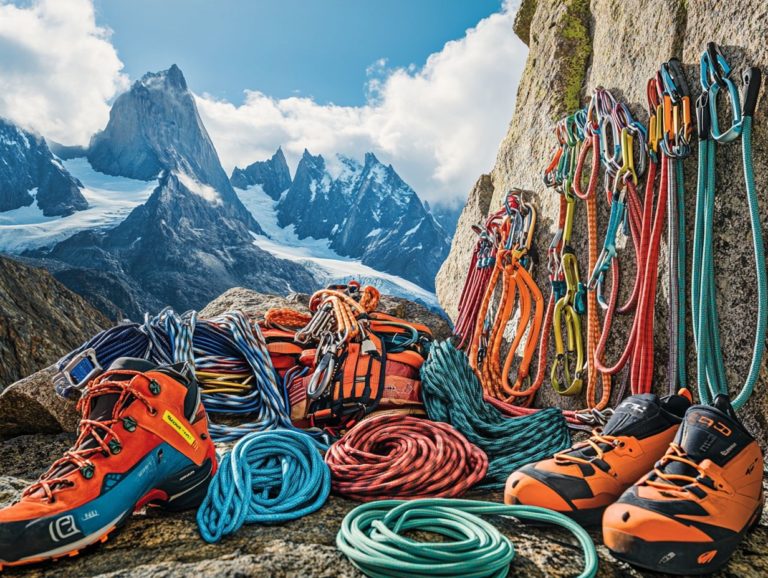Best Climbing Gear for Advanced Climbers
Are you prepared to elevate your climbing adventures to new heights? The right gear is essential for advanced climbers who prioritize both performance and safety.
Get ready to discover the climbing gear that will take your adventures to the next level! This article highlights the important climbing equipment that will enhance your experience, from specialized shoes designed for superior grip to harnesses that safeguard your security.
Whether you re conquering steep rock faces or navigating challenging routes, this comprehensive list features must-have gear specifically crafted for the serious climber.
Gear up now, stay safe, and take your climbing skills to new heights with these essential picks!
Contents
- Key Takeaways:
- 1. Climbing Shoes
- 2. Climbing Harness
- 3. Chalk Bag
- 4. Belay Device
- 5. Quickdraws
- 6. Rope
- 7. Carabiners
- 8. Climbing Helmet
- 9. Climbing Rope Bag
- 10. Climbing Gloves
- 11. Crash Pad
- 12. GriGri Device
- 13. Ascenders
- 14. Cams and Nuts
- 15. Climbing Clothing
- Frequently Asked Questions
- What type of climbing shoes are best for advanced climbers?
- Is it worth investing in a high-quality harness for advanced climbing?
- What features should I look for in a climbing rope for advanced climbing?
- Are there any specific types of chalk that are best for advanced climbers?
- What type of backpack is best for carrying climbing gear on advanced climbs?
- Essential Safety Equipment for Advanced Climbing
Key Takeaways:
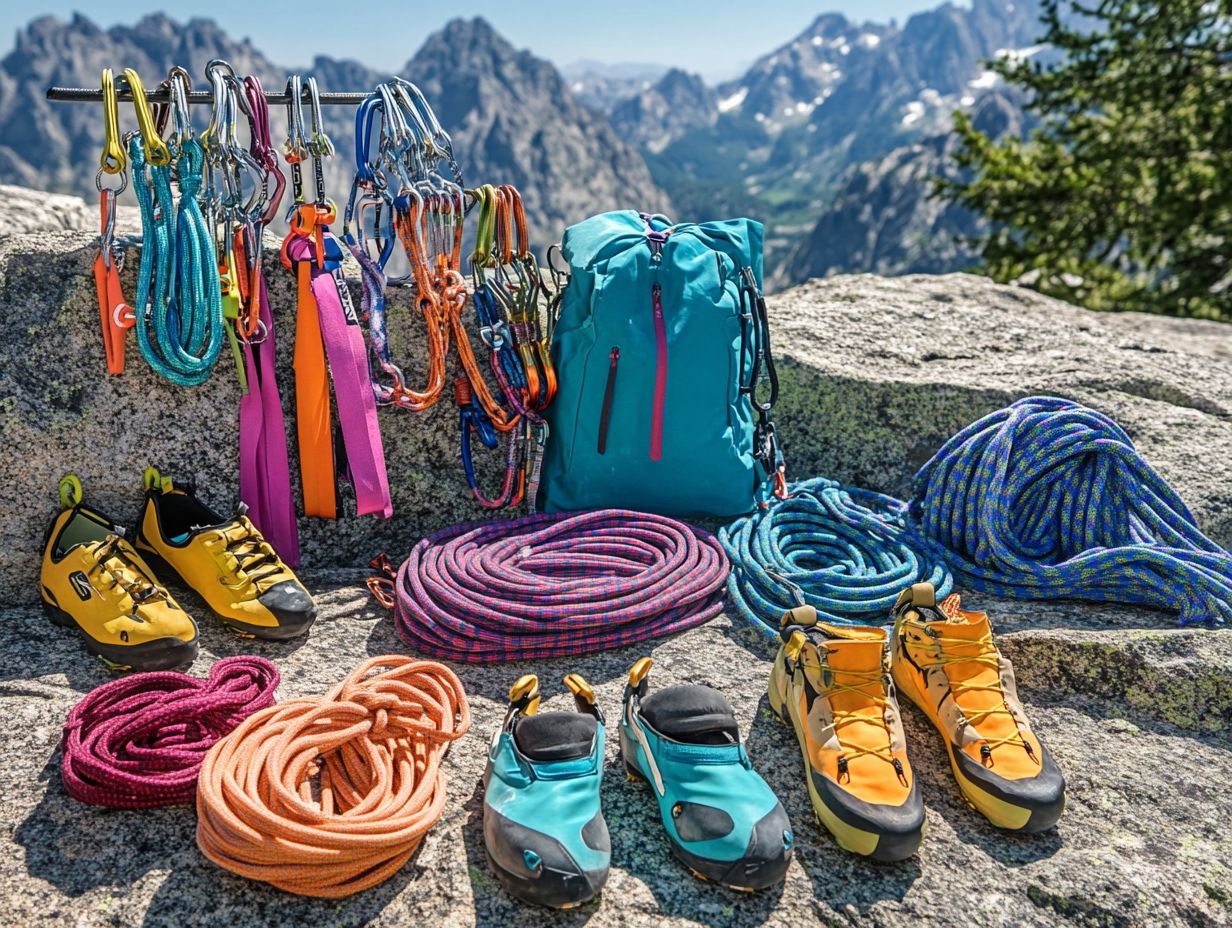
- Invest in high-quality, tight-fitting climbing shoes to improve your performance and prevent foot injuries.
- A comfortable and well-fitting climbing harness is essential for advanced climbers, providing support and safety while tackling challenging routes.
- A chalk bag is a must-have for advanced climbers, keeping hands dry and improving grip on holds.
1. Climbing Shoes
Climbing shoes are an essential part of your gear, crafted to elevate your performance, comfort, and safety as you tackle various climbing challenges be it the rugged cliffs of Yosemite or the boulders of British Columbia. Finding the right fit and material is crucial.
To navigate the diverse world of climbing, it’s vital to understand the different types of shoes available. You’ll find aggressive designs ideal for sport climbing that enhance precision on tiny footholds, as well as all-around options offering versatility for both indoor and outdoor climbs.
Take, for example, the La Sportiva Theory, which offers remarkable sensitivity and a downturned shape perfect for steep routes. In contrast, Scarpa’s Drago shines in flexibility and grip, making it a fantastic choice for bouldering.
Remember, a snug fit is crucial; a well-fitted shoe sharpens your technique and boosts your confidence when tackling challenging ascents. Considering the weight and breathability of the material ensures comfort during extended climbs. Thoughtful selections in these aspects are vital for both your performance and safety.
2. Climbing Harness
A climbing harness is a vital piece of climbing gear that safeguards your safety during both ascents and descents. It allows you to securely attach yourself to ropes and belay devices, with options ranging from lightweight sport harnesses for quick climbs to more robust models suited for mountaineering.
Choosing the right harness is essential. Each type is crafted with specific activities in mind think of the streamlined design of sport harnesses for rapid ascents versus the padded comfort of trad harnesses designed for lengthy multi-pitch routes.
If you’re venturing into mountaineering, you’ll find that these harnesses often come equipped with adjustable leg loops and gear loops, making it easier to carry the equipment you need while adapting to changing conditions. Many climbers turn to trusted brands like Black Diamond, renowned for their stringent safety ratings and innovative designs.
Understanding the nuances in weight, comfort, and functionality can profoundly influence your climbing experience, highlighting the importance of selecting a model that aligns perfectly with your chosen discipline. For those planning alpine climbs, considering the best climbing gear is essential.
3. Chalk Bag
A chalk bag is a small but essential piece of climbing gear that allows you to maintain your grip and prevent slips by keeping your hands dry. This enhances both your safety and performance as you tackle various terrains, from the Red River Gorge to Boulder, Colorado.
Your choice of chalk bag can dramatically influence your climbing experience. Different designs offer unique features tailored to specific climbing styles and environments. For example, a drawstring closure might be perfect for bouldering, while a zipper could be more suited for sport climbing.
The type of chalk you choose loose, block, or liquid can significantly impact your grip, especially in humid conditions where moisture can compromise your performance. It’s also important to consider how your chalk interacts with your shoe performance; excessive chalk can lead to a buildup that affects the fit of your shoes.
To ensure optimal grip and enjoyment, experiment to find what works best for you based on your individual preferences and the conditions you encounter.
4. Belay Device
Belay devices are essential for your climbing safety, enabling you to manage rope tension and catch falls effectively. Models like the Petzl Grigri and Edelrid Ohm II offer a range of features tailored to different climbing styles and safety needs.
Choosing between automatic and manual belay devices is crucial for safety and efficiency. Automatic devices, such as the Grigri, feature a hands-free locking mechanism that supports you in unexpected situations.
On the other hand, manual devices demand more engagement from you as the belayer, allowing for better control over the rope.
Understanding how each type works in various scenarios, be it sport climbing, trad climbing, or indoor gym settings, is crucial. Testing the gear and considering your personal preferences are vital steps; after all, what feels most comfortable and secure can differ significantly from one climber to the next. To ensure you have the right equipment, check out the best climbing gear for camping adventures.
5. Quickdraws
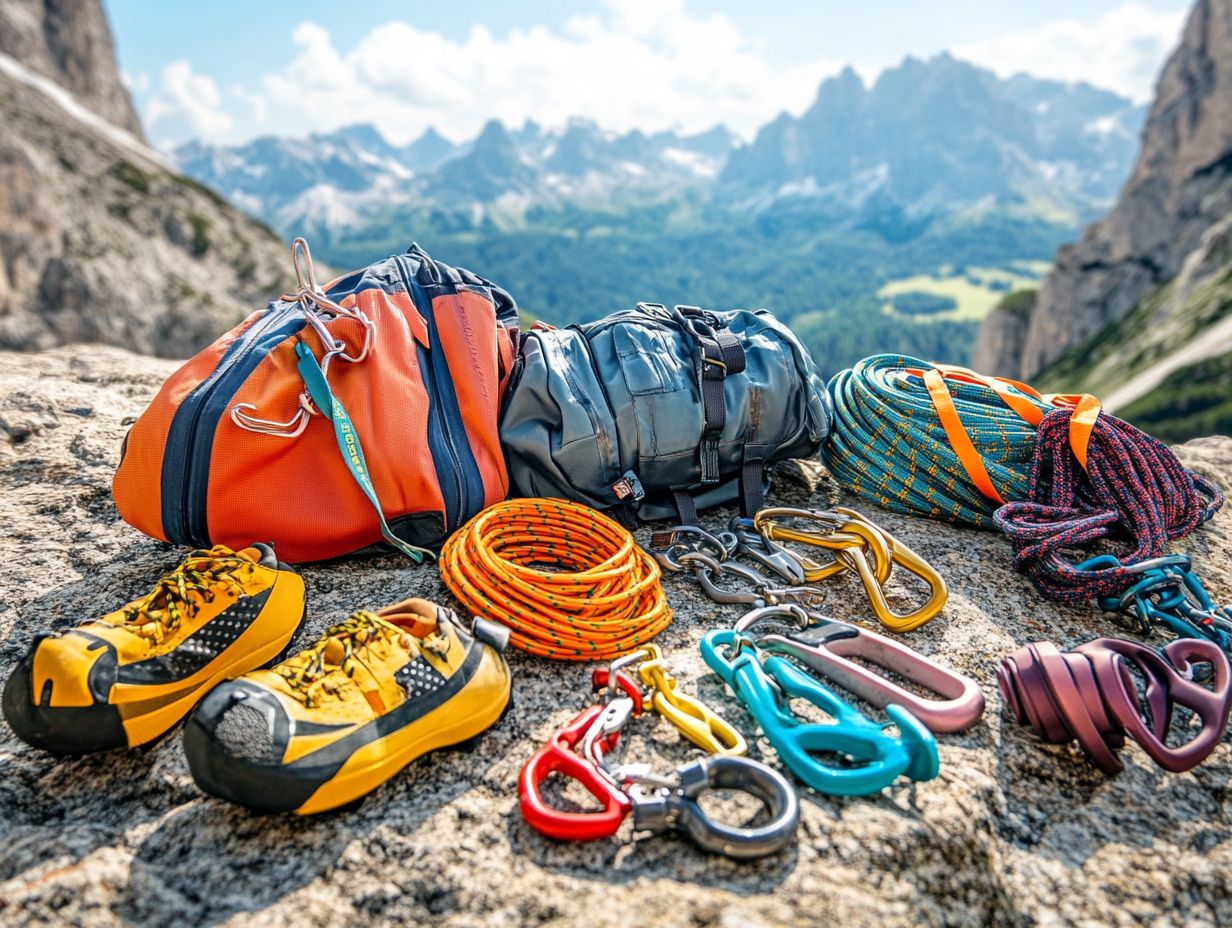
Quickdraws are essential tools in your climbing arsenal. They connect your rope to protection points like bolts, ensuring you ascend safely and efficiently, whether you’re tackling routes at Rifle Mountain Park or navigating urban climbing gyms.
The anatomy of a quickdraw is straightforward yet effective, featuring two carabiners linked by a durable sewn sling. This design allows for smooth rope movement while minimizing friction, making your climb more fluid.
When selecting quickdraws, consider the materials used in both the carabiners and slings. Aluminum offers a lightweight and budget-friendly option, while steel provides unmatched durability for tougher climbs.
Weight and gate strength are critical components to keep in mind. Lighter quickdraws will ease your overall load during climbs while a stronger gate is vital for ensuring your safety, especially on challenging routes.
If you’re in the market for reliable options, the Ocun Raven Quickdraw Zoom and Wild Country Electron Sport Draw are exceptional choices, renowned for their performance, reliability, and innovative design.
Don’t wait! Choose the right quickdraw to enhance your climbing experience now.
6. Rope
Selecting the right climbing rope is essential for your safety and performance, with options varying in diameter, length, and whether they re dynamic or static. These factors are crucial for preventing falls and ensuring secure descents in various climbing environments.
When determining the best rope for your climbing needs, it s important to grasp the distinct properties of dynamic and static ropes. Dynamic ropes stretch when loaded; this helps absorb the impact of a fall, making them perfect for sport climbing and trad climbing, where the risk of falls is significant.
On the other hand, static ropes do not stretch, making them ideal for tasks that require stability, such as mountaineering or rescue operations.
As a climber, assess factors like weight, handling, and durability, as these can greatly influence your performance and safety during your vertical adventures.
Ready to pick your perfect climbing rope? Let s dive into the options!
7. Carabiners
Carabiners are important parts of your climbing gear. They serve as crucial connectors for ropes, harnesses, and belay devices.
They come in various designs, including locking and non-locking options, ensuring your safety during climbs in stunning locations like Eldorado Canyon and Yosemite.
You ll find these devices made from a range of materials, such as aluminum and steel. Each material impacts weight and strength significantly. For example, the Trango Physic Pink Screwlock is a favored choice among climbers due to its durability and reliable locking mechanism.
Different types cater to specific needs. Lightweight aluminum carabiners are ideal for sport climbing, while the more robust steel versions are designed for heavy-duty applications, like rescue operations.
Understanding strength ratings, typically shown in kilonewtons (a measure of force), is essential for selecting gear that meets your safety requirements in various climbing scenarios.
8. Climbing Helmet
A climbing helmet is an essential piece of safety gear. It safeguards your head from falling objects and impacts, providing the security you need on challenging terrains, from cragging in Kentucky to multi-pitch climbs in British Columbia.
An effective climbing helmet combines several key features that prioritize safety while ensuring comfort. Weight is crucial; a lighter helmet allows for extended wear without fatigue, helping you focus on the climb ahead.
Ventilation keeps you cool during intense activity, while durability ensures the helmet withstands harsh conditions and potential impacts. A snug fit is a must for safety, as it minimizes the risk of shifting during a fall.
Comfort is important too; it encourages you to wear the helmet consistently.
Brands like Petzl, Black Diamond, and Mammut offer models that excel in these areas, catering to the diverse needs of every climber.
9. Climbing Rope Bag
A climbing rope bag protects your rope and makes it easy to carry. It ensures safety and longevity by minimizing damage from environmental factors and wear during your journeys to iconic climbing destinations like Yosemite and the Red River Gorge.
These bags come in many styles, including options tailored for single and double ropes. Each style boasts unique features such as padded compartments, built-in tarps, and reinforced straps.
A thoughtfully designed climbing rope bag simplifies gear transportation and prevents tangles and abrasions that could compromise your rope’s integrity over time.
Choosing a bag with sufficient capacity is essential. It allows you to carry your rope along with additional gear and essentials. This attention to organization fosters a more efficient climbing experience while considering the top climbing gear for rock climbers to keep safety at the forefront.
10. Climbing Gloves
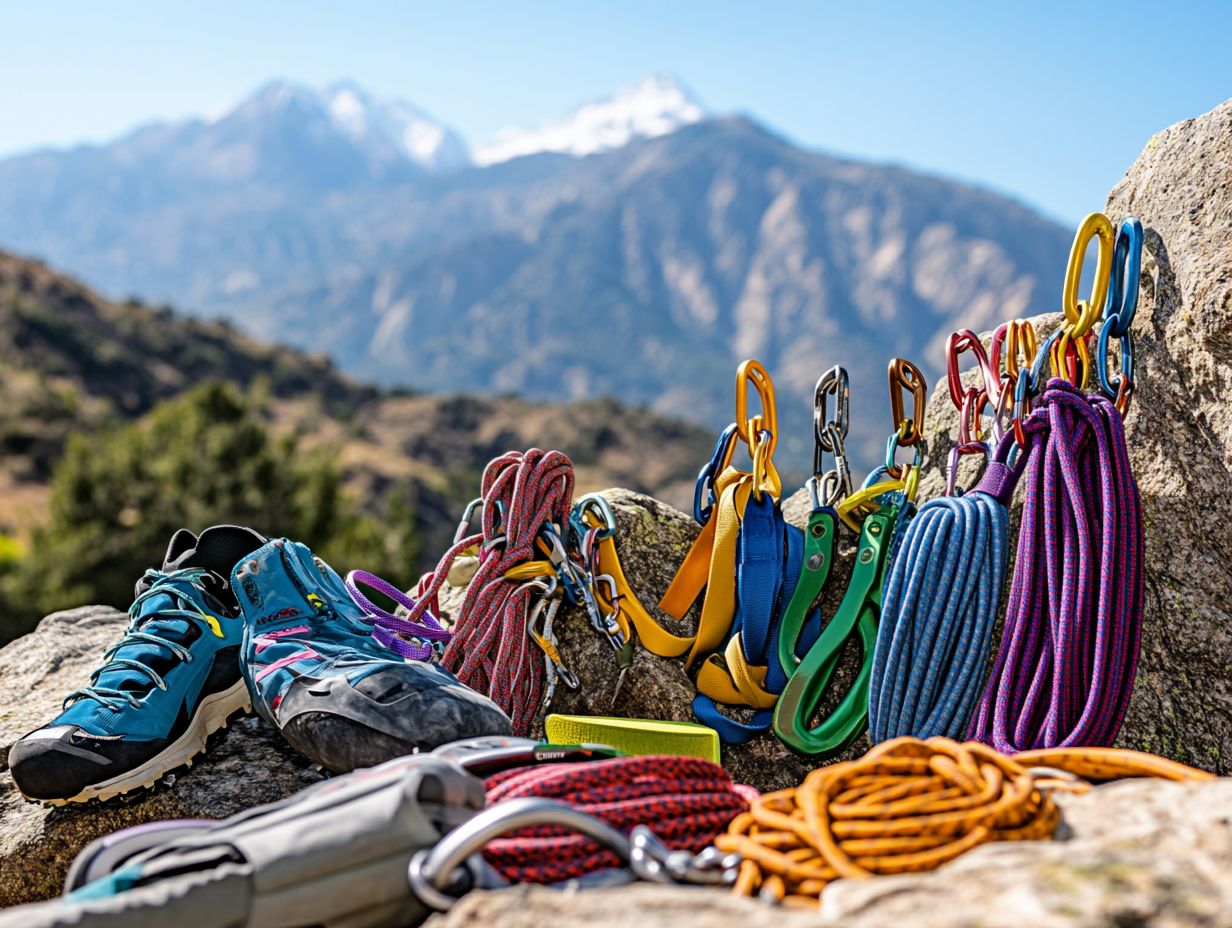
Climbing gloves act as your hands’ protective shield. They offer grip, warmth, and abrasion resistance essential elements of your climbing gear, especially during demanding ascents in chillier climates or when grappling with rough equipment.
You’ll find these gloves in various styles, crafted from specific materials like leather or synthetic fibers to maximize durability and flexibility.
For example, leather gloves often provide an exceptional grip and a snug fit, while synthetic options may have waterproof and breathable features that keep you comfortable.
When navigating rocky terrains or icy surfaces, gloves with reinforced palms are critical, preventing cuts and blisters. If you need to use your devices on the go, look for gloves with touchscreen compatibility, allowing you to stay connected without removing your gear.
Ultimately, selecting the right climbing gloves can elevate your climbing experience to new heights while ensuring your safety in diverse climbing conditions.
11. Crash Pad
A crash pad is an essential safety tool for bouldering. It offers crucial cushioning for climbers who may take a tumble. This gear not only reduces the risk of injury but also enhances your overall climbing experience, especially in popular spots like Boulder and Rifle Mountain Park.
Choosing the right crash pad can greatly influence your safety and comfort. Thickness is a key consideration. Thicker pads deliver superior shock absorption for higher falls, while a more compact option is perfect if you re looking to save space.
Size is another important factor. Larger pads offer more coverage, which is especially advantageous in areas with uneven landings. Don t underestimate portability; lightweight pads make it easy to transport your gear on those multi-climb days.
To find your ideal match, assess your usual bouldering situations. Strike a balance between the need for protection, transport convenience, and the specific terrain you ll be tackling.
12. GriGri Device
The GriGri device, especially the Petzl GriGri, is a top choice among climbers for belaying. Its automatic braking system enhances safety and simplifies the process. It s perfect for both beginners and seasoned climbers across various climbing scenarios.
This innovative device operates through a cam mechanism that locks the rope during sudden loads. This effectively reduces the risk of a fall. Unlike traditional belay devices that require constant attention, the GriGri allows you to focus on the climber while it securely holds the rope.
Its benefits are particularly noticeable in multi-pitch climbing, where managing rope slack can be tricky. The built-in safety features, including the anti-panic handle, provide crucial security during unexpected situations.
For optimal performance, familiarize yourself with the mechanics of the device and practice its functions regularly. This will help build confidence and ensure a seamless belaying experience.
13. Ascenders
Ascenders are your go-to climbing hardware for climbing fixed ropes easily. They enhance your safety during complex ascents in demanding environments like mountaineering or aid climbing.
These devices come in various styles tailored to specific needs, whether you’re sport climbing or involved in rescue operations. Their clever mechanisms grip the rope securely while allowing for smooth upward movement.
Take mechanical ascenders, for example. They provide the stability and reliability you need for long climbs. Mastering the proper techniques and adhering to safety precautions, like double-checking your gear, is key!
Best practices also emphasize the importance of regular equipment maintenance. Regular checks on your gear can make a life-saving difference!
14. Cams and Nuts
Cams and nuts are critical pieces of climbing hardware you rely on for protection. They secure you to rock features, significantly enhancing your safety as you navigate intricate routes in locations like Eldorado Canyon and the cliffs of Yosemite.
These devices cater to various rock formations and climbing scenarios, each offering distinct advantages. Cams provide a robust hold in parallel cracks, enhancing your versatility. Nuts excel in narrower, constricted spaces where a snug fit is essential.
When selecting the right equipment, assess the type of rock you’ll be climbing and your personal style. Also, consider the weight and ease of placement of your gear. For those interested in climbing indoors, understanding the essential gear for indoor climbing is important. Regularly testing your equipment is vital; inspect your hardware for signs of wear and tear to ensure optimal performance.
Proper maintenance, including cleaning and lubricating the moving parts, will prolong the lifespan of these essential tools. Additionally, having the right essential climbing gear for sport climbers is crucial to ensure a safe and enjoyable climb!
15. Climbing Clothing
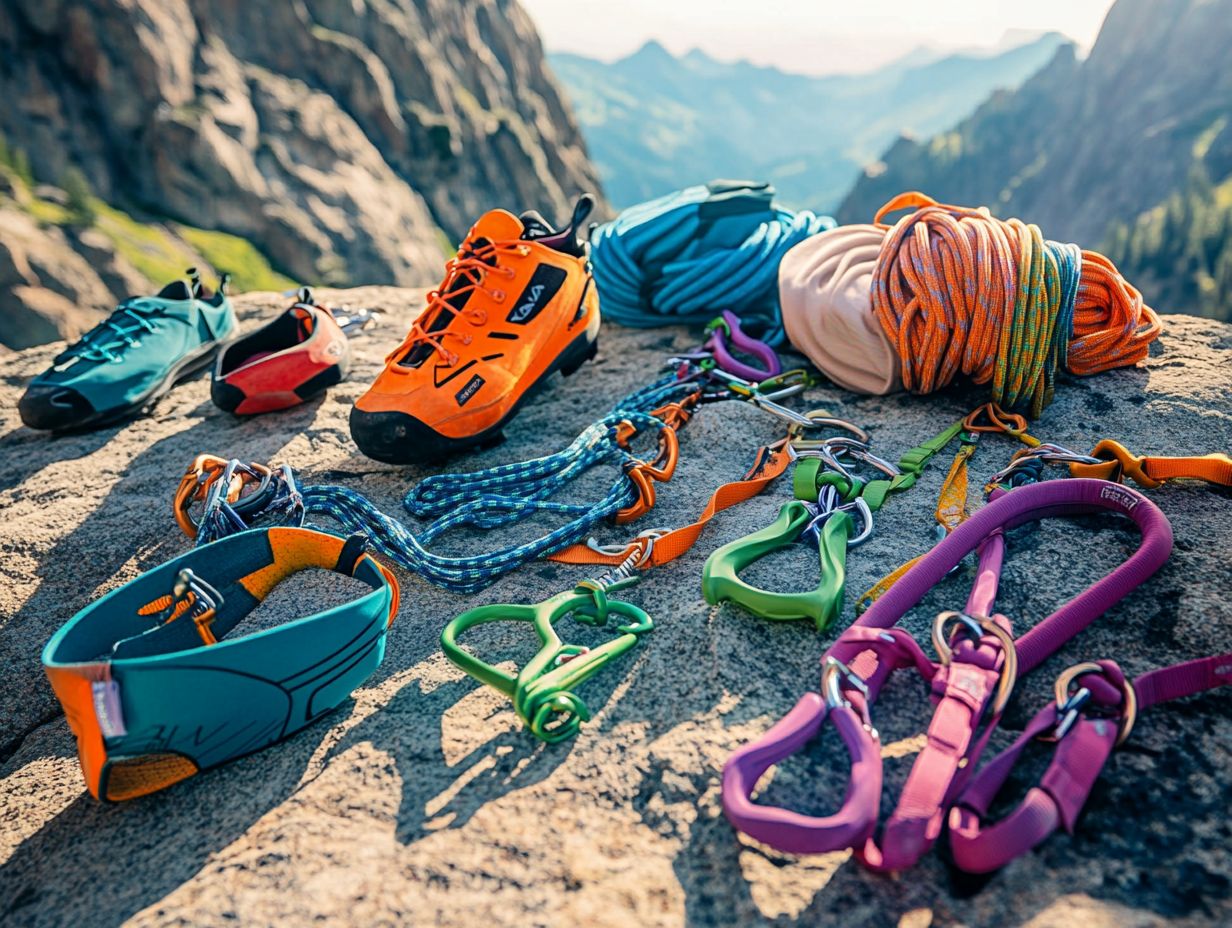
Climbing clothing is essential for enhancing your climbing experience. It provides comfort, flexibility, and protection against the elements, allowing you to move freely and safely in various environments, from chilly mountain ranges to sunny crags.
Choosing the right garments boosts your performance and meets the unique challenges of different terrains. You ll find various clothing types, including base layers that wick moisture away, mid-layers for insulation, and outer shells that protect against wind and rain.
Each piece is made from advanced fabrics that ensure breathability and stretch, perfectly suited to the dynamic movements of climbing. Thoughtful designs like pockets for your gear and features that minimize bulk enhance your experience, showing just how crucial appropriate gear is for safety and effectiveness. For those tackling tough environments, choosing the best climbing gear for extreme conditions is essential.
Frequently Asked Questions
What type of climbing shoes are best for advanced climbers?
When looking for climbing shoes for advanced climbers, make sure to think about the type of climbing you’ll be doing. Aggressive, downturned shoes are great for overhangs and bouldering. More neutral shoes work better for vertical or slab climbing.
Is it worth investing in a high-quality harness for advanced climbing?
Absolutely! Investing in a high-quality harness is crucial for advanced climbers. These harnesses often have extra padding and support, making them more comfortable for longer climbs. They also use stronger materials and designs to withstand more intense and technical routes.
What features should I look for in a climbing rope for advanced climbing?
For advanced climbing, look for a stretchy rope that s thinner and can handle more weight. This ensures flexibility and durability when taking falls on challenging routes. Also, think about the rope’s length and weight based on the climbs you plan to do.
Are there any specific types of chalk that are best for advanced climbers?
Chalk preference varies among climbers, but advanced climbers usually opt for chalk with higher magnesium content for better grip and sweat absorption. Many also prefer liquid chalk for longer routes, as it lasts longer and requires less reapplication.
What type of backpack is best for carrying climbing gear on advanced climbs?
A backpack made from durable and weather-resistant material, like nylon or canvas, is ideal for carrying climbing gear on advanced climbs. Look for one with multiple compartments and straps to secure and organize your gear. Hydration bladder compatibility is also beneficial for longer climbs. Using gear testing methods can help identify the most effective pack for various climbing environments like the Red River Gorge or Yosemite.
Essential Safety Equipment for Advanced Climbing
Advanced climbers need more than just the standard harness, rope, and climbing shoes. A helmet, quickdraws, carabiners, and a belay device are also crucial for safety.
Depending on the type of climbing, you might also need specialized gear. Items like the Edelrid Ohm II, Metolius Roll Up Stick Clip Kit, and Wild Country Electron Sport Draw can enhance your safety.
Assessing the weight of your gear is vital for efficiency on climbs, especially in challenging areas like Rifle Mountain Park and Eldorado Canyon. Stay prepared and climb safely!

